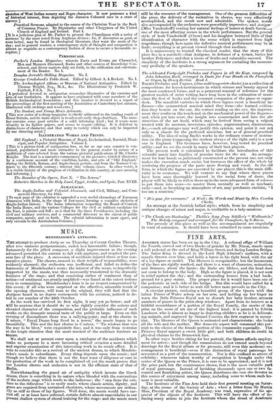FINE ARTS.
ANOTHER statue has been set up in the City. A colossal effigy of William the Fourth, carved out of two blocks of granite by Mr. Nixon, stands upon a tall pedestal at the end of King William Street, and facing London Bridge. The Sailor King is dressed in the Lord High Admiral's uniform, with a mantle thrown over him; and holds a baton in his right hand, with the air of a lay-figure or model. The likeness is recognizable; but the lineaments of the face are rigidly marked, and there is a want of character, animation, and firmness, about the figure: the limbs are lifeless, and the head does not seem to belong to the body. High as the figure is placed, it is not seen in relief against the sky; and the surrounding houses form a bad background for a grey statue. The proper place for it would have been one of the pedestals at each side of the bridge. But this would have called for a companion; and it is better to wait till better taste prevails in the City.
A circular picture, enclosing a beautiful group of the Queen with the infant Prince of Wales asleep on her arm, and holding up her finger to warn the little Princess Royal not to disturb her baby brother, attracts numbers of gazers in the print-shop windows. Apart from its interest as a faithful resemblance of a portion of the Royal Family, the merits of the print on the score of art are of the highest kind: it is painted by Edwin Landseer, who is almost as happy in depicting children as he is in delineating animals, and engraved by Samuel Cousins, the first engraver in mezzo tint. The likeness of the Queen is animated and characteristic: she looks all the wife and the mother. Her domestic aspect will commend this portrait to the choice of the female portion of the community especially. The Princess Royal appears a sweet little girl; and both children do credit in physical charms to the Brunswick line.
In other ways besides sitting for her portrait, the Queen affords employment for artists; and though the commissions do not extend much beyond drawings for the Royal album or for presents, still even this moderate encouragement is beneficial—even if the distinction of royal patronage be accounted as a part of the remuneration. Nor is this confined to artists of celebrity: whenever talent worthy of recognition is brought under the notice of the Queen or the Prince, it is sure to be appreciated; and it is not the price paid, but the countenance shown, that is the most valuable pad of royal patronage. Instead of lavishing thousands upon one or two favoured and flourishing artists, the Queen distributes the sum she devotes to this source of enjoyment among many, including some to whom such honour is most valuable.
The Institute of the Fine Arts held their first general meeting on Satarday, at the rooms of the Society of Arts ; when a letter from Sir Martin Shee, President of the /Loyal Academy, was read, expressive of his ap. proVal or the objects of the Institute. This will have the effect of inducing many artists to join the Institute whom the dread of Academie wpm:it:um would have deterred. Since the last meeting many have joined, luicl the Institute now numbers 376 members ; each of whom will in future be privileged to introduce a lady at the meetings. The prize of 201. for the best essay on the history, literature, and present state of art, was awarded to Mr. George Foggo ; who read a paper in reply to Mr. Hallam's remarks on subjects for the decoration of the Houses of Parliament, printed in the last Report of the Royal Commission. The matter is too controversial for discussion in our columns. We hope that as the Institute grows jts influence will be increased by the introduction of more distinguished men into the Council.























































 Previous page
Previous page